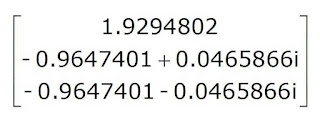There's a rather beautiful attractor called the Aizawa attractor: a sphere with a tube-like structure penetrating its axis [1] - a good candidate for the analog computer, in anticipation of the arrival of a new (old) oscilloscope from France.
The Aizawa attractor's equations are:
Given that there's precious little literature about this attractor, I have to plough my own furrow; I begin by searching for equilibrium points.
The game seems to be to set the left hand sides of the three equations to zero. Interestingly, by inspection, it's possible to solve the first two equations independently of the third, x = y = 0 being an obvious solution. In fact there are three solutions to the first pair of equations, obtainable, for example via:
Of these solutions, the first two can only yield real equilibrium points if x = y = 0; the third solution yields a complex equilibrium point, unless δ is zero or purely imaginary. If δ is zero then the first two equations would be decoupled. I am not sure what δ being imaginary would mean in terms of the analog computation - perhaps interpretable as a delay?
Given that equilibrium points should be real, since they exist in a real state space, we conclude that x = y = 0 for any such points - i.e. they must lie on the z-axis.
Setting x = y = 0 in the third equation, gives
Reference
[1] www.algosome.com/articles/aizawa-attractor-chaos.html
The Aizawa attractor's equations are:
Given that there's precious little literature about this attractor, I have to plough my own furrow; I begin by searching for equilibrium points.
The game seems to be to set the left hand sides of the three equations to zero. Interestingly, by inspection, it's possible to solve the first two equations independently of the third, x = y = 0 being an obvious solution. In fact there are three solutions to the first pair of equations, obtainable, for example via:
Of these solutions, the first two can only yield real equilibrium points if x = y = 0; the third solution yields a complex equilibrium point, unless δ is zero or purely imaginary. If δ is zero then the first two equations would be decoupled. I am not sure what δ being imaginary would mean in terms of the analog computation - perhaps interpretable as a delay?
Given that equilibrium points should be real, since they exist in a real state space, we conclude that x = y = 0 for any such points - i.e. they must lie on the z-axis.
Setting x = y = 0 in the third equation, gives
which has three solutions:
It is not obvious that any of these roots are purely real. But, for certain values of α and γ it transpires that they are...
...in all the published cases I can find, the Aizawa attractor uses the following parameter values: α = 0.95, β = 0.7, γ = 0.6, δ = 3.5, ε = 0.25 and ζ = 0.1, and plugging these values into the above equations gives the following (entirely real) roots for z:
Hence, for the parameter values listed, we expect three real equilibrium points, along the attractor's z-axis.
Now, clearly, λ depends solely on α and γ, and, as suspected, it's possible to adjust the value of (for example) α, so as to conjure up some complex values for z. A little experimentation shows that two of the roots become complex if α is reduced slightly, for example α = 0.93, yields:
which suggests just one (real) equilibrium point.
Indeed, it appears that the first root is always real, regardless of the value of α.
Further experimentation indicates that α ≈ 0.932169751786 is the point at which the second and third roots start to have a non-zero imaginary part. This value is intriguingly close to the 0.95 value which seems to be the de facto value for α used for the Aizawa attractor. I assume this is not a coincidence, and that the attractor 'needs' the three (real) equilibrium points to exist. It would be interesting to know how the 0.95 value was found.
Vieta's formula for the sum of roots of a polynomial tells us that the sum of the three roots of
(i.e. equilibrium positions along the z-axis) must equal zero (since the quadratic term in z is zero). Hence, if one root (equilibrium position) is real, then the others must either both be real, or both be complex (with equal but opposite imaginary parts). It would appear not to be possible to have just a single complex root (which would mean exactly two real equilibrium positions).
[1] www.algosome.com/articles/aizawa-attractor-chaos.html







Thank you very much for this beautiful post. A beautiful visualization of Aizawa can be found here: https://www.youtube.com/watch?v=RBqbQUu-p00
ReplyDelete